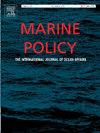Assessing marine traffic and related pressures and threats to cetacean populations to support vessel management in the Mascarene Important Marine Mammal Area
IF 3.5
2区 社会学
Q2 ENVIRONMENTAL STUDIES
引用次数: 0
Abstract
The global growth of marine traffic, among many growing anthropogenic threats, is of particular concern for marine mammals. Assessing the co-occurrence of marine traffic and cetacean distributions provide useful information for understanding the spatial extent and level of pressures and threats posed by vessels. Regional and local marine traffic is increasing within the territorial waters of Réunion Island, included in the Mascarenes Important Marine Mammal Area. This study provides the first description of the spatial distribution of vessels within these waters using Automatic Identification System (AIS) data and provides an assessment of the pressures and threats vessels may pose to five cetacean species (the spinner dolphin, the Indo-Pacific bottlenose dolphin, the common bottlenose dolphin, the pantropical spotted dolphin and the humpback whale). We found that vessels occurred in all Réunion waters and identified two highly-used shipping corridors on either side of the island. Our results highlighted areas of potential threats from marine traffic for each of the five species. These areas mostly mirrored their preferential core habitats, which raises concerns, especially for the resident and most vulnerable species. Given the increase in marine traffic in the western Indian Ocean region, this study provides additional information in support of an ongoing French initiative to implement an “Area to Be Avoided” in Réunion waters, in order to improve safety and security while also benefiting to cetacean conservation.
评估海上交通以及相关的对鲸类种群的压力和威胁,以支持马斯克林重要海洋哺乳动物区域的船只管理
在许多日益增长的人为威胁中,全球海洋交通的增长对海洋哺乳动物尤其令人担忧。评估海上交通和鲸类分布的共同发生,为了解船只造成的压力和威胁的空间范围和水平提供了有用的信息。包括在马斯卡林重要海洋哺乳动物区在内的雷姆苏因岛领海内的区域和地方海上交通正在增加。这项研究首次使用自动识别系统(AIS)数据描述了这些水域内船只的空间分布,并评估了船只可能对五种鲸目动物(飞旋海豚、印度太平洋宽吻海豚、普通宽吻海豚、泛热带斑点海豚和座头鲸)构成的压力和威胁。我们发现船只出现在所有东帝汶水域,并在该岛两侧确定了两条经常使用的航运走廊。我们的研究结果突出了海洋交通对五个物种的潜在威胁。这些区域大多反映了它们优先的核心栖息地,这引起了人们的关注,特别是对居民和最脆弱的物种。鉴于西印度洋地区海上交通的增加,这项研究提供了额外的信息,以支持法国正在进行的一项倡议,即在r union水域实施“避免区域”,以提高安全和保障,同时也有利于鲸类保护。
本文章由计算机程序翻译,如有差异,请以英文原文为准。
求助全文
约1分钟内获得全文
求助全文
来源期刊

Marine Policy
Multiple-
CiteScore
7.60
自引率
13.20%
发文量
428
期刊介绍:
Marine Policy is the leading journal of ocean policy studies. It offers researchers, analysts and policy makers a unique combination of analyses in the principal social science disciplines relevant to the formulation of marine policy. Major articles are contributed by specialists in marine affairs, including marine economists and marine resource managers, political scientists, marine scientists, international lawyers, geographers and anthropologists. Drawing on their expertise and research, the journal covers: international, regional and national marine policies; institutional arrangements for the management and regulation of marine activities, including fisheries and shipping; conflict resolution; marine pollution and environment; conservation and use of marine resources. Regular features of Marine Policy include research reports, conference reports and reports on current developments to keep readers up-to-date with the latest developments and research in ocean affairs.
 求助内容:
求助内容: 应助结果提醒方式:
应助结果提醒方式:


